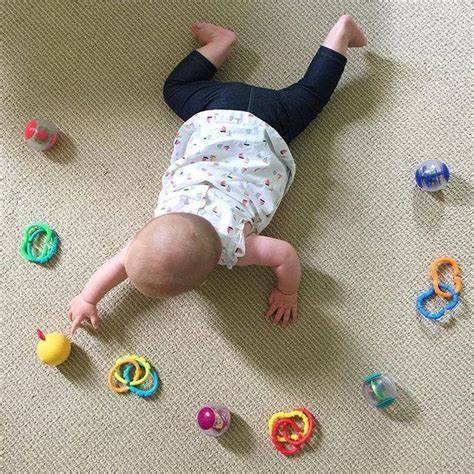Table of Contents
I’m sure you’ve heard of tummy time and its benefits. What is it really like? What if my baby doesn’t like tummy time?
According to the American Academy of Pediatrics (AAP), tummy time is crucial for a baby’s growth. It’s necessary to provide adequate supervised tummy time when your little one is awake to strengthen your baby’s upper body, head, and neck muscles.
Tummy time is beneficial for newborns and all babies alike. Engaging in tummy time activities can improve your baby’s coordination, strength, and play abilities, all of which are essential for crawling, reaching, and rolling over.
From this perspective, we at Omega Pediatrics recommend that you try tummy time for your baby, too! In this article, we at Omega Pediatrics will guide you through the basics of tummy time and how to incorporate fun activities for you and your little one to enjoy!

What’s Tummy Time and Its Importance?
Infant tummy time is when babies are placed on their stomachs while awake. It is an important activity that assists in strengthening the neck and shoulder muscles, which in turn improves their motor skills.
Tummy time activities are a great way to promote babies’ cognitive, sensory, and physical abilities while keeping them engaged and entertained. It’s beneficial for their growth and development and should be included in their daily routine.
Here are some tummy time benefits:
1. Tummy time develops your baby’s muscles.
Tummy time is important for infants 0–3 months since it essentially helps to develop neck control by lifting their heads and shoulders. At 4 months, babies gain control over rolling and crawling activities.
Tummy time helps prepare the baby for crawling by building the muscles needed for rolling over, sitting up, and walking. It helps to strengthen the neck, shoulders, and back muscles.
Babies aged 4 to 7 months, even though they have gained control over rolling and sitting up, still require some supervised tummy time activities.
Tummy time helps older babies enhance their arm, chest, and back muscles by lifting their head and chest further and then by straightening their arms. This activity strengthens the essential muscle groups required for their physical development.
2. Tummy time helps your baby’s neck muscles relax.
Newborn babies who suffer from a neck condition called torticollis, whose tight neck muscles hinder them from turning their heads, can benefit from tummy time activities.
Tummy time plays a crucial role in alleviating the associated symptoms. Combined with the doctor’s prescribed exercises, the activities encourage babies to look around, thus helping to relax their neck muscles.
3. Tummy time helps babies spend less time on their backs.
During the first few months, some babies develop positional plagiocephaly, or flat head syndrome. This is characterized by a flat spot on their head since they spend too much time lying on their back.
If the condition isn’t treated early on, it may need surgery to be fixed. Tummy time can help alleviate this condition.
4. Tummy time allows your little one to exercise.
Tummy time is a great way for your baby to exercise. There are various exercises to engage and play with your baby.
- Let your baby grab you!
One way is to place yourself or a toy just out of the baby’s reach to encourage them to grab it.
- Surround your baby with toys.
Place toys in a circle around the baby. This helps them develop the necessary muscles for rolling over, crawling, and scooting on their belly.
- Place your baby facing you while you lie down.
Promote your baby’s development by lying on your back and placing them on your chest. Let them gaze at your face by lifting their heads and using their arms to reach you.
- Have another child play with your baby.
Involve an older sibling in the activity under adult supervision. This allows the older child to have fun and gives your baby a chance to interact and socialize with others.

How does Tummy Time Work?
To perform tummy time, you place your baby on their stomach while they are awake for a brief duration.
Newborns
To introduce tummy time for newborns, lay them on their stomachs across your lap or chest for short periods multiple times a day. Gradually increase the duration as your baby becomes more comfortable. The best time is after a diaper change or a nap.
Older Infants
To initiate tummy time, spread a blanket on a flat surface and place your baby on their stomach on the blanket for a few minutes, multiple times a day. Expect the baby to become fussy and uncomfortable during the sessions.
As your baby gets used to tummy time, gradually increase the duration and frequency. Experts recommend working up to about an hour of tummy time a day by the time your baby reaches 3 months.
You can encourage your baby to push and look up by making noises. Placing your baby’s toy in front of them is one way to promote reaching and forward movement.
To encourage your little one’s development, experts recommend interacting with them on their tummy a few times a day for short periods of 3-5 minutes per session. As they grow and become stronger, they will require more time on their tummies to develop their strength.

What Should I Do If My Little One Doesn’t Like Tummy Time?
To make tummy time more enjoyable for your baby, try different activities, such as singing songs or keeping colorful toys nearby. Engage them by lowering yourself to the floor to make eye contact. Inviting others can also make it a fun and interactive session.
It’s normal for some babies to resist tummy time at first, so don’t give up. With patience and practice, they will become more comfortable in this position and reap the benefits it offers for their development.
You can also place toys or yourself just within reach for your baby to play with. Your baby will enjoy tummy time and play in this position over time.
3 Fun Activities To Make Tummy Time Enjoyable
Here are some tummy time ideas and infant playtime activities to try if your baby is having trouble tolerating tummy time or even if they are already enjoying it:
1. Use animated voices and silly expressions
Start practicing tummy time as early as possible, even in the hospital. To begin with, position your newborn on your stomach or chest while awake, and in a reclined position, tummy to tummy with the baby.
This helps your baby accept the stomach as a natural position. Use exaggerated expressions to keep your baby engaged. This is a great opportunity for socializing and bonding with your newborn.
2. Place your baby on your lap
To add more variety to tummy time, place your baby on your lap lengthwise while supporting the head. It’s crucial to ensure that your baby’s head and body are aligned during tummy time. Try to raise and lower your legs or sway to help your baby relax.
Tummy time also exposes your baby to different surface textures. The best place is on the floor or on a soft mat or carpet with various textures. This allows your baby’s skin to feel different surfaces and helps her understand her body’s location.
During tummy time, your baby also gains strength and flexibility. Putting her in a onesie allows her to feel textures on her arms and legs.
Tummy time lets babies discover and visually explore the environment from a different perspective. This position allows them to lift their heads and see things at eye level, giving them a different view!
3. Let your baby face sideways while playing
If your baby doesn’t like being on their stomach, you can try side-lying as an alternative. Place your baby on their side on a blanket, propping their back up with a rolled-up towel if necessary.
Ensure the head is supported by a small washcloth, if needed. Keep their arms in front while bending their legs at the hips and knees for comfort. In this position, engage your baby with a toy or a book to keep them entertained.
It’s important to schedule regular tummy time and side-lying sessions, such as after naps, baths, or diaper changes. Change the baby’s position during playtime every 10–15 minutes.
Additionally, you can also hold your baby and have them sit on your lap to expose them to different positions. Connecting emotionally with your baby and engaging in interactive playtime is crucial.

Important Tips During Tummy Time
Never leave your baby’s side.
Babies need to have tummy time to build strong muscles while awake and under supervision. For safety reasons, it is a must to always be by your baby’s side and monitor them to avoid unexpected accidents.
Place your baby on their back when sleeping.
Put your little one on their back when putting them to sleep. Never leave them in a tummy-time position to reduce the chances of SIDS (sudden infant death syndrome).
Ask permission from your pediatrician if your baby has special needs.
If you have a premature baby, have reflex problems, or have other special needs, consult your pediatrician before initiating tummy time. This ensures your newborn’s safety.
Start Tummy Time Now!
Tummy time is a vital method to aid in developing neck and shoulder muscles and enhancing motor abilities in infants. Because of its numerous benefits, we at Omega Pediatrics recommend that you start tummy time now!
Need more guidance on how tummy time works? We at Omega Pediatrics could help you with that.
FAQ
What is tummy time, and why is it important for my baby?
Tummy time is when babies are placed on their stomachs while awake to strengthen their muscles, particularly in the neck and shoulders. It promotes motor skills development and prepares them for activities like crawling and rolling over.
How can I introduce tummy time to my newborn?
Begin tummy time by laying your baby on your lap or chest for short periods multiple times a day. Gradually increase the duration as your baby becomes more comfortable, starting shortly after birth.
What if my baby doesn’t like tummy time?
If your baby resists tummy time, try different activities like singing songs, using colorful toys, or making eye contact to engage them. With patience and practice, most babies become more comfortable with tummy time over time.
What are some fun activities to make tummy time enjoyable for my baby?
Use animated voices, place your baby on your lap, or let them face sideways while playing to add variety to tummy time. Regularly changing positions and engaging in interactive play can make tummy time more enjoyable for your baby.
What are some important tips for tummy time?
Always supervise your baby during tummy time, place them on their back when sleeping, and consult your pediatrician if your baby has special needs. Starting tummy time early and ensuring consistent supervision are crucial for your baby’s safety and development.



